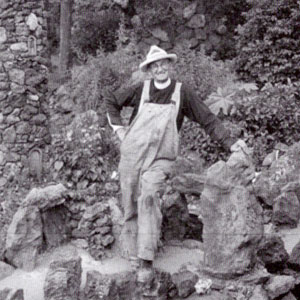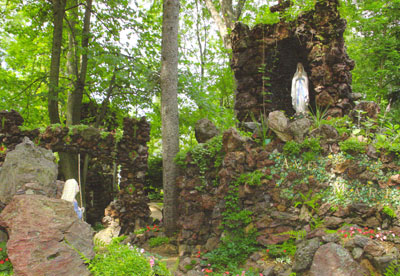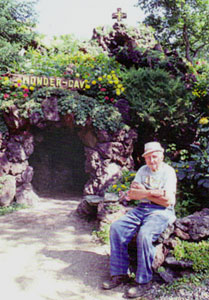Grotto History
A Promise to Mary
The Grotto was built as a fulfillment of a promise made by Father Philip Wagner while studying for the priesthood in Europe in 1912. With seriously failing health, Father visited Our Lady's Shrine in Lourdes, France (well known for healing) and promised to Mary that, if his heath were to be restored allowing him to be ordained, he would build a shrine in her honor some day. His condition slowly improved and as his strength returned, his courage revived. He came to realize that many would never have the oppotunity to journey to places of spiritual importance, and it was in this realization that the beginnings of the Grotto were formed.

Father Wagner - Fulfilling the Promise
Building the Grotto
Father Wagner was ordained in 1915, and in 1917, he was assigned to St. Philomena's Church in Rudolph. In 1919, his work began when it was decided to build a new church that would be more centrally located in the village. Looking at the new parish grounds and at the rolling countryside he knew "This was it - the place I was looking for, where my dreams were to be realized".
He had never built a wall in his life and didn't even know how to mix mortar. Nevertheless, he began to plant trees. Flower bed construction and rock collection from the surrounding area soon followed. The first shrine was begun in 1927. Stones and large rocks were piled because he knew nothing of masonry.

Lourdes Shrine - the first shrine built in the Grotto
The Co-Builder
Edmund Rybicki began helping Fr. Wagner on a steady basis in 1928 when he was 12 years old. His father thought that Fr. Wagner's work was important so he allowed Edmund to work at the Grotto instead of on the farm. Edumund became Father's "right-hand man - the staff of my life." Edmund mixed the first batch of concrete and in 1928, the Lourdes Shrine, the first in Father Wagner's Grotto, was completed. At first Edmund just brought the materials to Father, but eventually they became a team, designing and building from an imaginary plan that they jointly devised. When Edmund grew up, he became the custodian for the church and school in addition to being the co-builder of the Grotto, and he devoted his life to helping Father Wagner bring his promised Grotto into existence. Even after retiring in 1979, Edmund could be found most week day mornings caring for the Grotto that his friend had dedicated himself to create.

Edmund Rybicki - Father Wagner's right-hand man
A Continued Labor of Love
Father Wagner's health once again failed in the late 1950's. After his death in 1959, Father Garlan Muller was appointed pastor of St. Philomena's. In 1961, Saint Philomena's Church was rededicated and given the name of St. Philip the Apostle in honor of Father Philip Wagner. Just as Father Wagner had loved the Grotto, so too, did Father Muller. He continued the building and nurturing of the Grotto until he suffered a severe heart attack and retired in 1969. Father Robert Perkins was then appointed pastor, and was also inspired by the Grotto. He worked on the final construction projects with Edmund and local volunteers. The last project was completed in the spring of 1983.
Over the years, thousands of tons of rock were hauled from local farms and used to create the Shrines and unique formations that make up the grotto. The Wonder Cave is a one-fifth mile passageway featuring 26 shrines and was patterned after the catacombs in Rome. The hand-carved plaques and statues were made from the finest marble in the world in Carerra Italy to the exact specifications of Father Wagner. A variety of shells, marbles, tiles and colored glass all give the Grotto its unique appearance.
Today most of the work done at the Grotto is by volunteers who believe it is a symbol of peace and harmony; a lasting memorial to the faith and devotion of one man - Father Philip J. Wagner.

Kris Willfahrt (center), full-time grounds keeper with volunteers Connie Jagodzinski and Louise Hartjes. Behind them is the Grotto truck Father Wagner and Edmund purchased used and equipped with a dump box.
